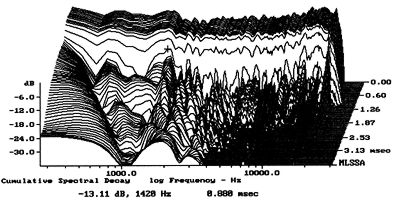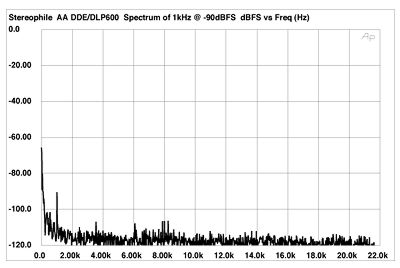| Columns Retired Columns & Blogs |
Celestion SL600si loudspeaker & DLP600 digital equalizer 1992 Measurements part 2
Fig.10 shows the impulse response of the SL600Si on its HF axis at 45" when corrected by the DLP. You can see that it is very much more like fig.9 than fig.8 (though inverted). Note also that the ultrasonic ringing has been eliminated, if for no other reason than the fact that there is now no signal content above 22kHz, and that the speaker's output has been delayed by a small amount.
Footnote 1: If the additional complexities of the twos-complement encoding are ignored.

Fig.10 Celestion SL600si equalized by DLP600, impulse response on tweeter axis at 45" (5ms time window, 30kHz bandwidth).
To look at what is happening from a different viewpoint, the MLSSA system allows you to calculate the step response once you have captured the impulse response. (A perfect loudspeaker step response would look like a right triangle, with a vertical move away from the time axis followed by an angled straight line back to it.) Fig.11 shows the step response of the uncorrected '600Si. The output of the tweeter moves to the negative side of the time axis, then back again, overshooting a bit on the other side. The woofer then follows, its output stepping in the opposite direction (though not at right angles, due to its slow risetime), then gradually falling back and overshooting the time axis. With a second-order crossover, driving the two drivers in opposite polarity results in an ostensibly flat amplitude response, this being achieved, as shown in fig.11, at the expense of the time-domain performance.

Fig.11 Celestion SL600si, step response on tweeter axis at 45" (5ms time window, 30kHz bandwidth).
Now look at fig.12. Ignoring the slight bump just before 5.5ms, which I imagine is due to the correcting impulse not being optimal at this measuring distance and on this axis, there is a noticeable, sharp step away from the time axis, followed by a reasonable straight-line fallback. (The latter still overshoots, however, due to the correction filter not having a sufficient number of coefficients to correct for such low-frequency behavior.)

Fig.12 Celestion SL600si equalized by DLP600, step response on tweeter axis at 45" (5ms time window, 30kHz bandwidth).
Note that the woofer output is not only now effectively coincident in time with that of the tweeter, its output is in the opposite polarity to that in fig.11, as suggested by the phase response in fig.7. (Because of this change in low-frequency polarity, switching the EQ in or out can give a slight "pop.") The DLP600 allows the speaker designer to have his cake and eat it too: second-order slopes with time-coincident, same-polarity drive-units and flat amplitude response in the crossover region.
The effect of the DLP can also be noted in the loudspeaker's cumulative spectral-decay or "waterfall" plots. Fig.13 shows the plot for the uncorrected '600, fig.14 that for the same loudspeaker with the DLP applying its correction. The treble in fig.13 appears somewhat hashy, though it actually is quite good in absolute terms. (Ignore the resonant ridge just below 16kHz, which is a computer artifact.) There is also some complicated behavior at the top of the woofer passband, between 1kHz and 2kHz. This hasn't been affected in fig.14, but note how the entire treble region is not only more flat, but falls away in a much more even manner.

Fig.13 Celestion SL600si, cumulative spectral-decay plot at 45" (0.15ms risetime).

Fig.14 Celestion SL600si equalized by DLP600, cumulative spectral-decay plot at 45" (0.15ms risetime).
Fig.15 shows in more detail how the DLP's amplitude response from fig.7 (the bottom trace in fig.15, now plotted on a 5dB/division vertical scale) affects the '600Si's measured frequency response on the listening axis. The top trace is the original response; the middle trace is the response after equalization. Note that the EQ peak in the top octave seems a little excessive, the result in this region being slightly boosted. This may well correlate with the slight "ffff" effect occasionally noted during the auditioning. This slight peakiness can also be seen in the spatially averaged room response (fig.16), the bottom curve above 630Hz being the original 1/3-octave measured response and the top one that after being corrected by the DLP600. The bumps and dips below 300Hz are room-resonant effects which haven't been eliminated by the spatial averaging, but note how smooth the corrected speaker is throughout the upper midrange and treble. Here's the reason the SL600Si/DLP600 combination sounds so tonally natural.

Fig.15 Celestion SL600si (from top to bottom): unequalized anechoic response on tweeter axis; equalized anechoic response on tweeter axis; effect of DLP600 (5dB/vertical div.).

Fig.16 Celestion SL600si, spatially averaged, 1/3-octave, freefield response in JA's listening room with (red) and without (blue) Celestion DLP600.
These measurements appear to reinforce just how effective the DLP600 is at improving the sound of the SL600Si. But, "No pain, no gain," say the philosophers, so I looked at its performance in the digital domain to see whether it introduced any compromises there. Remember that fig.7 showed the DLP600 introducing boosts at various frequencies. If you think about this, this can't be possible. A digital system cannot increase the level of an input signal to be above 0dBFS; at that point, all the 16 bits are "used up." The word representing the maximum positive level in twos-complement binary arithmetic as used in the CD system is 0111111111111111. If you attempt to take the signal just one bit higher, that word changes to 1000000000000000, which is the maximum negative level. That kind of change would be horribly audible, so DSP engines are arranged just to latch or clip at the maximum level, which is also audible (if a little less horrible). This is hardly elegant, however, so if digital equalizers appear to introduce gain, what they actually do is attenuate the overall signal except at some frequencies.
This turned out to be the case with the DLP600. Feeding a digital 1kHz sinewave at -10dBFS into the Audio Alchemy DDE from the Audio Precision S/PDIF output gave me a reference level; physically inserting the DLP600 into the data chain (with its equalization switched out) reduced the DDE's analog output level by exactly 6.02dB. This means that before the DLP applies any tonal compensation, it reduces the signal level by half. (The way it does this is trivial—it divides the number represented by every digital word by two, a process that fundamentally consists of moving every bit in that word one place to the right. (footnote 1) The Celestion engineers therefore could apply up to 6dB boost at some frequencies if they wished; as shown in fig.7, they ended up with a maximum boost of 4.7dB at 15.1kHz (footnote 2).
As a natural consequence of this 6dB reduction in signal level, the signal's dynamic range is compromised by the same 6dB. This can be seen in figs.17 and 18. The former shows the audio-band spectrum of the Audio Alchemy DDE's output when reproducing a dithered 1kHz sinewave at -90.31dB; the latter the DDE's output when fed by the DLP600. (I have adjusted for the 6dB difference in level.) Note the rise in the noise floor, as expected. But note also something that surprised me: fig.17 shows that the Audio Alchemy's residual non-linearity at very low levels introduces a small amount of second-harmonic distortion (the spectral line at 2kHz in fig.17) (footnote 3).

Fig.17 Audio Alchemy DDE, spectrum of dithered 1kHz tone at -90dBFS (10dB/vertical div.).
Fig.18 shows that if the DLP doesn't actually eliminate this distortion entirely, it significantly reduces its level, from -18dB with respect to the fundamental level to -25dB. There is also a slight reduction in the DDE's noise content around 8kHz, which may be due to a residual idling tone in its oversampling Bitstream filter/DAC combination. In addition, looking at linearity (fig.19), this sample of the Audio Alchemy featured a maximum negative level error of -1dB at -86dB. Allowing for the drop in absolute level due to the DLP600, it reduced the maximum-level negative error to -0.4dB, though there was a higher positive error below -90dB, presumably due to the raising of the noise floor with respect to the signal level.

Fig.18 Celestion DLP600/Audio Alchemy DDE, spectrum of dithered 1kHz tone at -90dBFS (10dB/vertical div.).

Fig.19 Audio Alchemy DDE, linearity error at 500Hz with (bottom) and without (top) Celestion DLP600 (2dB/vertical div., right channel dashed).
The implication here is that the DLP improves the low-level performance of the DAC to which it is attached. Actually, what I believe is happening is that it is the addition of 1 LSB's worth of noise which improves the DAC's low-level performance. I examined this by listening to the 500Hz fade-to-noise track from the CBS Test CD with and without the DLP physically in the chain and with the replay gain set all the way up. With the VTL DAC, I could hear no difference other than the slightly higher noise level, which suggests that the processor's UltraAnalog DAC needs no help. With the Audio Alchemy DAC, the signal's audible second-harmonic content at this very high replay level was slightly reduced in level, as was the HF hash. Even with the DLP600, however, the quality of the low-level tone via the DDE didn't approach that from the VTL on its own.—John Atkinson
Footnote 1: If the additional complexities of the twos-complement encoding are ignored.
Footnote 2: A word of caution for those who want to do A/B tests on the effects of the DLP600. Even with the EQ switched out, the DLP600 attenuates the data. However, using a digital "tone" with a frequency below the band where the EQ has any effect, 250Hz, showed that switching the EQ in with the DLP's front-panel button raised its level by 0.56dB. As well as the tonal shaping and time-domain equalization, there is therefore a slight change in level. To those who argue that this must be the reason I heard a difference, however—get real!
Footnote 3: This sample of the DDE, which had served time chez Corey Greenberg, was better in this respect than the one reviewed by Robert Harley last August (Vol.14 No.8, August 1991, p.131).
- Log in or register to post comments




































